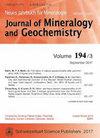黑云母成分变化——用物理化学方法研究伊朗马拉耶-博鲁杰德深部杂岩中侏罗统地壳参与和找矿潜力
IF 0.8
4区 地球科学
Q4 MINERALOGY
引用次数: 1
摘要
黑云母是Zagros造山带Malayer Boroujerd Plutonic杂岩(MBPC)花岗岩类中最常见的铁磁相。黑云母的丰度从花岗岩类向闪长质侵入体、闪长质和辉长岩岩脉向辉长岩侵入体递减,同时角闪石/黑云母比例增加。MBPC花岗质岩石(富铁型)中的原生岩浆黑云母成分从annite变为菱铁矿,而蚀变辉长岩和辉长岩-闪长岩脉中的贫铁次生黑云母接近金云母-东长岩系,而那些蚀变最少的辉长岩中的次生黑云母显示出这些组的平均成分,但向高Al端成员延伸。使用黑云母地热计中的Ti,MBPC花岗质岩石的结晶温度在550°C至750°C之间变化(P 10–15 bar)。模式III:辉长岩和闪长岩脉以及辉长岩侵入体中黑云母在较高氧化条件下结晶(f(O2)>10–10 bar)。从I型到S型花岗岩(HM以上到QFM以下缓冲区)f(O2)值和氧化条件的逐渐降低反映了岩浆发生过程中氧化程度较低的上部地壳物质的掺入增加。此外,MBPC镁铁质侵入岩中的最高f(O2)与适度的地壳污染(如果有的话)一致。斑岩型蚀变分带和与斑岩铜系统相关的次火山斑岩侵入体缺乏证据。NW-MBPC中的小块钙硅酸盐岩石与氧化程度较低、分馏程度较高的地壳衍生粒状花岗质岩石接触形成,不太容易形成Cu-Au矿化。然而,考虑到相对较高的f(O2)值,源自SaSiZ下方变躯体化地幔楔的中侏罗世镁铁质侵入岩似乎是该地区进一步找矿计划的最佳候选者。本文章由计算机程序翻译,如有差异,请以英文原文为准。
Biotite compositional variations – A physicochemical approach to investigate crustal involvement and ore potential in Middle Jurassic plutonic rocks from the Malayer-Boroujerd Plutonic complex, W Iran
Biotite is the most frequent ferromagnesian phase in granitoids from the Malayer-Boroujerd Plutonic complex (MBPC), Zagros Orogen. The abundance of biotite decreases from granitoids towards dioritic intrusions, dioritic and gabbroic dykes to gabbroic intrusions coincident with increase in hornblende/biotite ratio. Primary magmatic biotite composition in the MBPC granitoids (Fe-rich type) changes from annite to siderophyllite, while Fe-depleted secondary biotites from the altered gabbros and gabbroic-dioritic dykes approximate to the phlogopite-eastonite series, and those from least-altered gabbros display average composition of these groups, however, extend towards high-Al end-members. Using Ti-in-biotite geothermometer, the crystallization temperature varies between 550 °C to 750 °C in MBPC granitoids (P 10–15 bars). Mode-III: biotite crystallized at higher oxidizing conditions (f(O2) > 10–10 bars) in gabbroic and dioritic dykes as well as gabbroic intrusions. The progressive decreases in f (O 2)–values and oxidizing conditions from I-type to S-type granites (above HM-to below QFM-buffer) reflect increasing incorporation of less-oxidized upper crustal materials during magmagenesis. In addition, the highest f (O2) in MBPC mafic intrusive rocks is consistent with a modest crustal contamination, if any. There is lack of evidence for porphyry type alteration zoning and subvolcanic porphyritic intrusions associated with porphyry copper system. The small patches of calc-silicate rocks from the NW-MBPC formed in contact with less oxidized and highly fractionated, crustal-derived granular granitoids and are less predisposed to develop Cu-Au mineraliza- tion. However, given the relatively higher f (O2)-values, the Middle Jurassic mafic intrusive rocks originated from the meta- somatised mantle-wedge beneath SaSiZ, appears to be the best candidate for further ore exploration programs in the area.
求助全文
通过发布文献求助,成功后即可免费获取论文全文。
去求助
来源期刊
CiteScore
0.90
自引率
20.00%
发文量
6
审稿时长
>12 weeks
期刊介绍:
Neues Jahrbuch für Mineralogie (Abhandlungen) publishes thorough, detailed studies of up to 30 printed pages as well as short and concise papers and notes (less than 15 printed pages) on mineralogy, i.e. crystallography, crystal chemistry, petrology, geochemistry and economic mineralogy (mineral deposits).
All fields of mineralogy: crystallography, crystal chemistry, petrology, geochemistry and economic mineralogy (mineral deposits).

 求助内容:
求助内容: 应助结果提醒方式:
应助结果提醒方式:


